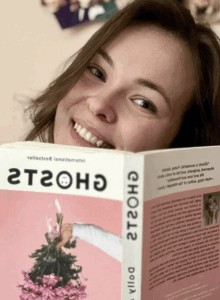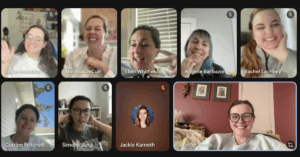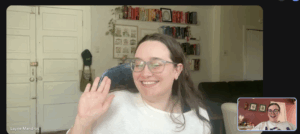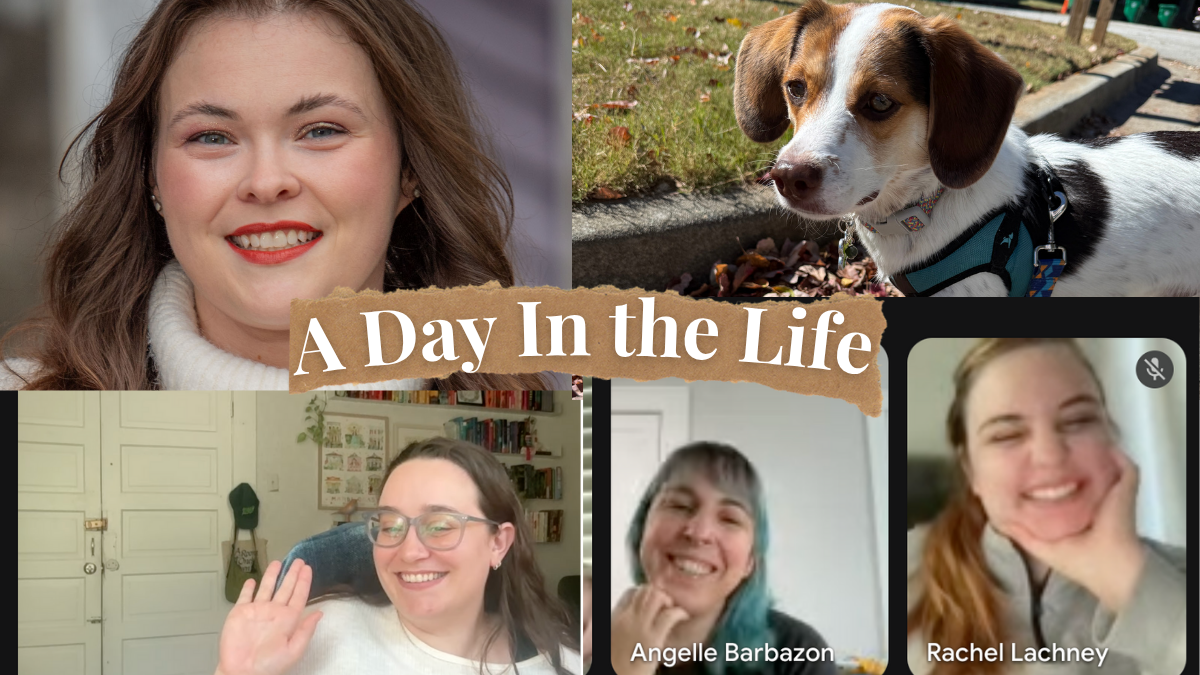Books Forward is celebrating our 25th anniversary this year, and one of the ways we’re celebrating is by showcasing 25 people you should know in the book world. There are many unique roles in the book world, and the many kinds of people who play a part in the community we love.

Today, we’re getting to know our very own marketing director, Jenn Vance (she/her)! Stay up to date on other industry professionals by reading our Lit Happens blog throughout the year.
8 a.m.
I am NOT a morning person. So I have to give myself plenty of time to wake up and turn into a normal human being before I start work. That usually consists of scrolling through Instagram and TikTok and saying good morning to my partner and our menagerie (3 cats, 1 dog).
8:45 a.m.
 I start every day looking through my email and catching up there. Some days are busier than others. But because it’s Monday, I’m catching up on things that came through during the weekend. I’m an inbox zero girlie, so I try to get there before I start work if I can. (Today was a success!!)
I start every day looking through my email and catching up there. Some days are busier than others. But because it’s Monday, I’m catching up on things that came through during the weekend. I’m an inbox zero girlie, so I try to get there before I start work if I can. (Today was a success!!)
9:20 a.m.
I monitor some Amazon and Facebook ads I’m running for authors before I hop on a few calls. I like to do this early on Monday because they’ve been running over the weekend. And now is a good time to make adjustments if needed.
9:45 a.m.
I have a call with a potential new author client in a few minutes so I am reviewing the info they sent us so we can have a productive call. As the marketing director, I talk with a lot of clients on the front end who might be interested in digital-focused campaigns.
This might be weird, but I LOVE talking to authors. I feel most comfortable on calls or in author groups, answering questions and talking about the industry.
10 a.m.
I hopped on that call with the prospective new author and it went really well! She asked a lot of really good questions, which is the sign of a great partner in promotion. I’m excited about this one because we are planning a more influencer-focused tour. And that means swag boxes! Swag boxes can be intense designing and ordering everything for them. But it’s sooo satisfying when everything finally comes together and you get to mail it out to readers.
I’ll be working up a proposal for this author this week and sending it over to her so she has time to review. We spend a lot of time on the front end writing proposals since we tailor each campaign to an author’s specific goals and budget.
10:40 a.m.
I respond to some messages that came in during my call. Also took a look at my inbox — including a response from someone I pitched last week who’s interested in taking a look at a book! Now’s also a good time to grab a nice, cold Diet Coke before I hop on team call.
 11 a.m.
11 a.m.
Time for our weekly Books Forward team call! Because our team is spread out in different cities and states, I love our weekly calls to get to see everyone’s beautiful faces. Team calls are different every week, but these are a great chance to review campaigns and brainstorm together.
We have some new campaigns starting, so we shared contacts for outlets that might be good for these specific campaigns. And we also voted on some book titles for a forthcoming novel our sister company Books Fluent is working on.
This call was great because we reviewed some successful pitches, including one for an author who will be appearing on the Kelly Clarkson Show! Seeing how other people on the team pitch is helpful and really great to keep ideas fresh.

 12 p.m.
12 p.m.
I have to eat lunch now or it will be past the point of no return. My current lunch hyperfixation meal is breakfast burritos. But today I made a special Franksenstein meal of leftovers that resulted in a delicious beef short rib and mac and cheese quesadilla.
12:20 p.m.
My puppy, Barry, is only 9 months old and has tons of energy. So I set aside some of my lunch time to take him on a walk and play with him. The temperatures in the Atlanta area have been cooling down recently. So I can actually enjoy an afternoon walk without sweating!
12:45 p.m.
Checking back in on my inbox to see what all has come in while I was on my calls and away for lunch. Thankfully, not too much! Today is mostly questions from the team, as well as some correspondence with an author and the library I’m helping set up an event with.
 1 p.m.
1 p.m.
I typically have a weekly call with Layne, one of our publicists and digital strategists. We ran through her clients and talked through how their ads were performing. And we were brainstorming some potential promotions for an author interested in working more with book clubs.
Video calls are also prime time for my cats to remind me that they’re my actual supervisors. I can’t get on a call without one of them making an appearance!
2 p.m.
We have our monthly influencer newsletter going out tomorrow. I’m giving it one final look over and updating our audience with recent sign-ups before scheduling.
2:30 p.m.
We’ve been working on a postcard to send to our author family to celebrate our 25th anniversary. So it’s time to finally sit down and design that. Designing is one of my other favorite parts of my job. And we have some fun things in the works next year for a blog featuring past Books Forward authors!
4:00 p.m.
Finalizing a press kit for a new campaign I started. This one is a musical audiobook and I’m super excited for it! Press kits are the perfect combination of editing (my other love) and design. This author had a lot of great input as well, and we’re both really happy with the finished product.
4:30 p.m.
Taking one final look at my inbox before I log off for the day. After this, it’s more puppy time and have to start thinking about what to make for dinner. I might peek at my emails during the evening, but I usually try not to respond to anything until the next morning.

Jennifer Vance is a publicist at Books Forward, an author publicity and book marketing firm committed to promoting voices from a diverse variety of communities. From book reviews and author events, to social media and digital marketing, we help authors find success and connect with readers.
Interested in what’s possible for your book sales and building readership? Check out our services, tell us your goals, and get a customized publicity campaign tailored just for you.









